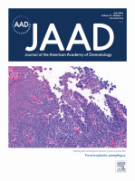Detection of Ro/SS-A antibodies in lupus erythematosus: What does it mean for the dermatologist? - 09/02/13
 , Gunda Stanarevic, MTA a, Norbert T. Sepp, MD a, b
, Gunda Stanarevic, MTA a, Norbert T. Sepp, MD a, bAbstract |
Background |
Lupus erythematosus (LE) is a systemic autoimmune disease. However, some patients have only cutaneous LE (CLE), whereas others develop internal organ involvement. Ro/SS-A antibodies are frequently detected in photosensitive variants of LE.
Objective |
The prevalence of LE-specific and LE-nonspecific cutaneous manifestations and their relation to internal organ involvement in Ro/SS-A antibody–positive patients were investigated.
Methods |
All Ro/SS-A-positive patients between January 2000 and December 2011 were reviewed. Only patients with Ro/SS-A antibodies and LE were enrolled and retrospectively analyzed.
Results |
In all, 215 Ro/SS-A antibody–positive patients were given the diagnosis of LE. Older patients (>50 years old) presenting with subacute CLE or chronic CLE and negative antinuclear antibody usually only experienced skin involvement. In contrast, internal organ involvement was observed in younger patients (<50 years old) with subacute CLE or chronic CLE presenting with the clinical and laboratory markers: fatigue, positive antinuclear antibody, and additional extractable nuclear antigen. Young female patients with acute CLE should be recognized as a separate subset of Ro/SS-A antibody–positive patients because almost a third was given the diagnosis of kidney involvement. Logistic regression analysis revealed that internal organ involvement was observed in patients with LE presenting with LE-nonspecific cutaneous manifestations, arthralgia, leukopenia, positive antinuclear antibody, and fatigue.
Limitations |
This was a retrospective study from a single referral center specializing in dermatologic diseases.
Conclusion |
The particular cutaneous variant of LE and age at Ro/SS-A detection predict different risks for internal organ involvement in Ro/SS-A antibody–positive patients with LE.
Le texte complet de cet article est disponible en PDF.Key words : internal organ involvement, lupus erythematosus, lupus erythematosus–nonspecific cutaneous manifestations, lupus erythematosus–specific cutaneous manifestations, Ro/SS-A antibody
Abbreviations used : ACLE, ANA, APS, ARA, CCLE, CHLE, CI, CLE, DLE, ENA, LE, LET, MLE, OR, SCLE, SLE, SS
Plan
| Funding sources: None. |
|
| Conflicts of interest: None declared. |
Vol 68 - N° 3
P. 385-394 - mars 2013 Retour au numéroBienvenue sur EM-consulte, la référence des professionnels de santé.
L’accès au texte intégral de cet article nécessite un abonnement.
Déjà abonné à cette revue ?

